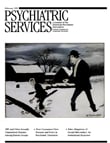Consumer perceptions of pressure and force in psychiatric treatments
Abstract
OBJECTIVE: Mental health consumers with serious mental illness were surveyed to obtain information about their experiences with and attitudes toward forced psychiatric treatment. METHODS: A 61-item survey questionnaire developed by the authors was administered by consumer volunteers to 105 persons with serious mental illness who were attending seven rehabilitation centers in Maryland. The questionnaire covered consumers' experiences and attitudes in three areas of forced treatment: medication, outpatient therapy or rehabilitation, and hospitalization. RESULTS: At some time during the course of their illness, 57 percent of the respondents reported having been pressured or forced into hospitalization. In the year before the survey, 30 percent reported being pressured or forced into taking medication and 26 percent into attending a therapy or rehabilitation program. The most common type of pressure or force was verbal persuasion. Generally, respondents reported negative effects from forced treatment, although the intensity of the negative effects varied by treatment area, and about half retrospectively felt that the forced treatment was in their best interest. Many respondents believed that pressure or force has an appropriate role in psychiatric treatment, although most wished to maintain the right to refuse treatment that they considered not in their best interest. CONCLUSIONS: Differences in patterns of response to pressure and force in the three treatment areas highlight the variety of consumer experiences and the need to know more about the role of forced or pressured treatment in their lives.
Access content
To read the fulltext, please use one of the options below to sign in or purchase access.- Personal login
- Institutional Login
- Sign in via OpenAthens
- Register for access
-
Please login/register if you wish to pair your device and check access availability.
Not a subscriber?
PsychiatryOnline subscription options offer access to the DSM-5 library, books, journals, CME, and patient resources. This all-in-one virtual library provides psychiatrists and mental health professionals with key resources for diagnosis, treatment, research, and professional development.
Need more help? PsychiatryOnline Customer Service may be reached by emailing [email protected] or by calling 800-368-5777 (in the U.S.) or 703-907-7322 (outside the U.S.).



